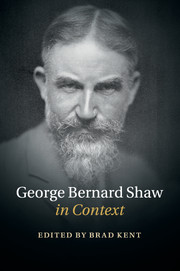Book contents
- Frontmatter
- Dedication
- Contents
- List of illustrations
- Notes on contributors
- Preface
- Acknowledgements
- A Chronology of Shaw's Works
- List of abbreviations
- PART I PEOPLE AND PLACES
- PART II THEATRE
- PART III WRITING AND THE ARTS
- 15 Cinema
- 16 Journalism
- 17 Letters
- 18 Media and technology
- 19 Modernism
- 20 Music
- 21 Novels
- 22 Publishers and publishing
- 23 Visual arts
- PART IV POLITICS
- PART V CULTURE AND SOCIETY
- PART VI RECEPTION AND AFTERLIFE
- Further reading
- Index
- References
23 - Visual arts
from PART III - WRITING AND THE ARTS
Published online by Cambridge University Press: 05 October 2015
- Frontmatter
- Dedication
- Contents
- List of illustrations
- Notes on contributors
- Preface
- Acknowledgements
- A Chronology of Shaw's Works
- List of abbreviations
- PART I PEOPLE AND PLACES
- PART II THEATRE
- PART III WRITING AND THE ARTS
- 15 Cinema
- 16 Journalism
- 17 Letters
- 18 Media and technology
- 19 Modernism
- 20 Music
- 21 Novels
- 22 Publishers and publishing
- 23 Visual arts
- PART IV POLITICS
- PART V CULTURE AND SOCIETY
- PART VI RECEPTION AND AFTERLIFE
- Further reading
- Index
- References
Summary
Well into his late teens, Shaw had serious hopes of becoming a painter. Over a decade later he unexpectedly became a professional art critic for four solid years. Then and thereafter he commanded an impressive fund of reference in the canon of Western art and regularly hobnobbed with contemporary artists in his political and personal life and in the theatre. And while the visual arts may have played a lesser role than music in shaping Shaw's own most vibrant imaginative creations, namely his plays, nevertheless they had a lasting role in framing the aesthetic issues he sought to engage in his craft and criticism. He lived long, and as far as the art of his time goes, its contextualising importance tilts to the era before World War I. In his later years, it is apparent that his liveliest personal engagement had shifted from the traditional forms to those upstart muses, photography and cinema.
In seeking to set Shaw in the context of the visual arts, four centres of interest clamour for attention: Dublin and what it had to offer in his self-education of eye and hand; his milieu and practice as a London art critic; the trace of art in the visuality and subject matter of his plays; and his involvements as subject in portraiture and as practitioner in photography and film.
Dublin did not offer a rich soil for the cultivation of the visual arts during Shaw's youth, but he took advantage of opportunities for instruction in drawing (at extra charge) in the schools he attended until sixteen, and in classes that taught freehand drawing and perspective at the Royal Dublin Society School of the Arts. Most of his education in visual art came, he claimed, from borrowed volumes of an encyclopaedic ‘Museum of Painting and Sculpture’, and purchased volumes of a Bohn Library translation of Giorgio Vasari; and above all from the rooms he haunted in the National Gallery of Ireland with his friend, Edward McNulty. Shaw was later to credit the NGI with providing much of his real education, and he rallied to its support in later controversies, eventually leaving it a third of his posthumous royalties, which proved a bonanza.
- Type
- Chapter
- Information
- George Bernard Shaw in Context , pp. 183 - 196Publisher: Cambridge University PressPrint publication year: 2015



